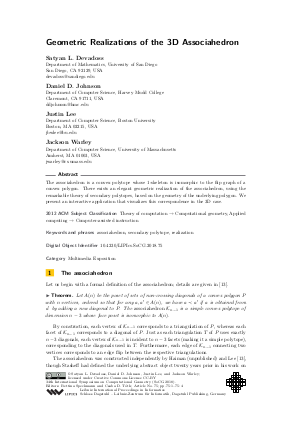Geometric Realizations of the 3D Associahedron (Multimedia Exposition)
Authors Satyan L. Devadoss, Daniel D. Johnson, Justin Lee, Jackson Warley
-
Part of:
Volume:
34th International Symposium on Computational Geometry (SoCG 2018)
Part of: Series: Leibniz International Proceedings in Informatics (LIPIcs)
Part of: Conference: Symposium on Computational Geometry (SoCG) - License:
 Creative Commons Attribution 3.0 Unported license
Creative Commons Attribution 3.0 Unported license
- Publication Date: 2018-06-08
File

PDF
LIPIcs.SoCG.2018.75.pdf
- Filesize: 0.82 MB
- 4 pages
Document Identifiers
Subject Classification
Keywords
- associahedron
- secondary polytope
- realization
Metrics
- Access Statistics
-
Total Accesses (updated on a weekly basis)
0Document
0Metadata
Abstract
The associahedron is a convex polytope whose 1-skeleton is isomorphic to the flip graph of a convex polygon. There exists an elegant geometric realization of the associahedron, using the remarkable theory of secondary polytopes, based on the geometry of the underlying polygon. We present an interactive application that visualizes this correspondence in the 3D case.
Cite As Get BibTex
Satyan L. Devadoss, Daniel D. Johnson, Justin Lee, and Jackson Warley. Geometric Realizations of the 3D Associahedron (Multimedia Exposition). In 34th International Symposium on Computational Geometry (SoCG 2018). Leibniz International Proceedings in Informatics (LIPIcs), Volume 99, pp. 75:1-75:4, Schloss Dagstuhl – Leibniz-Zentrum für Informatik (2018)
https://doi.org/10.4230/LIPIcs.SoCG.2018.75
BibTex
@InProceedings{devadoss_et_al:LIPIcs.SoCG.2018.75,
author = {Devadoss, Satyan L. and Johnson, Daniel D. and Lee, Justin and Warley, Jackson},
title = {{Geometric Realizations of the 3D Associahedron}},
booktitle = {34th International Symposium on Computational Geometry (SoCG 2018)},
pages = {75:1--75:4},
series = {Leibniz International Proceedings in Informatics (LIPIcs)},
ISBN = {978-3-95977-066-8},
ISSN = {1868-8969},
year = {2018},
volume = {99},
editor = {Speckmann, Bettina and T\'{o}th, Csaba D.},
publisher = {Schloss Dagstuhl -- Leibniz-Zentrum f{\"u}r Informatik},
address = {Dagstuhl, Germany},
URL = {https://drops.dagstuhl.de/entities/document/10.4230/LIPIcs.SoCG.2018.75},
URN = {urn:nbn:de:0030-drops-87886},
doi = {10.4230/LIPIcs.SoCG.2018.75},
annote = {Keywords: associahedron, secondary polytope, realization}
}
Author Details
References
-
Louis J Billera, Susan P Holmes, and Karen Vogtmann. Geometry of the space of phylogenetic trees. Advances in Applied Mathematics, 27(4):733-767, 2001.

-
Michael Bostock, Vadim Ogievetsky, and Jeffrey Heer. D³ data-driven documents. IEEE transactions on visualization and computer graphics, 17(12):2301-2309, 2011.

- Ricardo Cabello et al. Three.js, 2010. URL: https://github.com/mrdoob/three.js.
-
Cesar Ceballos, Francisco Santos, and Günter M Ziegler. Many non-equivalent realizations of the associahedron. Combinatorica, 35:513-551, 2015.

-
Frederic Chapoton, Sergey Fomin, and Andrei Zelevinsky. Polytopal realizations of generalized associahedra. Bulletin Canadien de Mathématiques, 45:537-566, 2002.

-
Satyan L Devadoss. Tessellations of moduli spaces and the mosaic operad. Contemporary Mathematics, 239:91-114, 1999.

-
Satyan L Devadoss and Joseph O'Rourke. Discrete and Computational Geometry. Princeton University Press, 2011.

-
Satyan L Devadoss, Rahul Shah, Xuancheng Shao, and Ezra Winston. Deformations of associahedra and visibility graphs. Contributions to Discrete Mathematics, 7:68-81, 2012.

-
Kenji Fukaya, Yong-Geun Oh, Hiroshi Ohta, and Kaoru Ono. Lagrangian intersection Floer theory: Anomaly and obstruction. American Mathematical Society, 2010.

-
Israel M Gelfand, Mikhail Kapranov, and Andrei Zelevinsky. Discriminants, Resultants, and Multidimensional Determinants. Springer, 2008.

-
Christophe Hohlweg and Carsten Lange. Realizations of the associahedron and cyclohedron. Discrete &Computational Geometry, 37(4):517-543, 2007.

- Ivan Kuckir. PolyK.js. URL: http://polyk.ivank.net/.
-
Carl W Lee. The associahedron and triangulations of the n-gon. European Journal of Combinatorics, 10:551-560, 1989.

-
Chiu-Chu Melissa Liu. Moduli of J-holomorphic curves with Lagrangian boundary conditions and open Gromov-Witten invariants for an S¹-equivariant pair. arXiv math/0210257, 2002.

- Sébastien Loisel. Numeric javascript. URL: http://www.numericjs.com/.
-
Alexander Postnikov. Permutohedra, associahedra, and beyond. International Mathematics Research Notices, 2009:1026-1106, 2009.

-
Jim Stasheff. From operads to ‘physically’ inspired theories. In Operads: Proceedings of Renaissance Conferences, volume 202, page 53. American Mathematical Society, 1997.

-
M Yoshida. Hypergeometric functions, my love. Vieweg, 1997.

